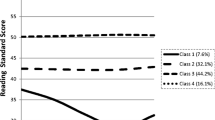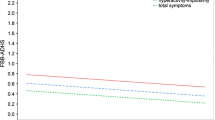Abstract
We examined trajectories of academic and social functioning in children with attention-deficit/hyperactivity disorder (ADHD) to identify those who might be at risk for especially severe levels of academic and social impairment over time. We estimated a series of growth mixture models using data from two subsamples of children participating in the NIMH Collaborative Multisite Multimodal Treatment Study of Children with ADHD (MTA) including those with at least baseline and 96-month data for reading and mathematics achievement (n = 392; 77.3% male; M age = 7.7; SD = 0.8) or social skills ratings from teachers (n = 259; 74.9% male; M age = 7.6; SD = 0.8). We compared latent trajectories for children with ADHD to mean observed trajectories obtained from a local normative (i.e., non-ADHD) comparison group (n = 289; 80.6% male; M age = 9.9; SD = 1.1). Results indicated six latent trajectory classes for reading and mathematics and four classes for teacher social skills ratings. There was not only a relationship between trajectories of inattention symptoms and academic impairment, but also a similarly strong association between trajectory classes of hyperactive-impulsive symptoms and achievement. Trajectory class membership correlated with socio-demographic and diagnostic characteristics, inattention and hyperactive-impulsive symptom trajectories, externalizing behavior in school, and treatment receipt and dosage. Although children with ADHD display substantial heterogeneity in their reading, math, and social skills growth trajectories, those with behavioral and socio-demographic disadvantages are especially likely to display severe levels of academic and social impairment over time. Evidence-based early screening and intervention that directly address academic and social impairments in elementary school-aged children with ADHD are warranted. The ClinicalTrials.gov identifier is NCT00000388.





Similar content being viewed by others
References
Abikoff, H., Gallagher, R., Wells, K. C., Murray, D. W., Huang, L., Lu, F., & Petkova, E. (2013). Remediating organizational functioning in children with ADHD: Immediate and long-term effects from a randomized controlled trial. Journal of Consulting and Clinical Psychology, 81, 113–128.
Achenbach, T. M. (1991). Manual for the teacher report form. Burlington, VT: University of Vermont, Department of Psychiatry.
American Psychiatric Association. (2013). Diagnostic and statistical manual of mental disorders (5th ed.). Washington, D.C.: Author.
Arnold, L. E., Ganocy, S. J., Mount, K., Youngstrom, E. A., Frazier, T., Fristad, M., et al. (2014). Three-year latent class trajectories of attention-deficit/hyperactivity disorder (ADHD) symptoms in a clinical sample not selected for ADHD. Journal of the American Academy of Child & Adolescent Psychiatry, 53, 745–760.
Barkley, R. A. (Ed.). (2015). Attention-deficit/hyperactivity disorder: A handbook for diagnosis and treatment (4th ed.). New York: Guilford.
Barkley, R. A., Fischer, M., Smallish, L., & Fletcher, K. (2006). Young adult outcome of hyperactive children: Adaptive functioning in major life activities. Journal of the American Academy of Child and Adolescent Psychiatry, 45, 192–202.
Booster, G. D., DuPaul, G. J., Eiraldi, R., & Power, T. J. (2012). Functional impairments in children with ADHD: Unique effects of age and comorbid status. Journal of Attention Disorders, 16, 179–189.
Bussing, R., Fernandez, M., Harwood, M., Hou, W., Garyan, C. W., Eyberg, S. M., & Swanson, J. M. (2008). Parent and teacher SNAP-IV ratings of attention deficit hyperactivity disorder symptoms: Psychometric properties and normative ratings from a school district sample. Assessment, 15, 317–328.
Bussing, R., Porter, P., Zima, B. T., Mason, D., Garvan, C., & Reid, R. (2012). Academic outcome trajectories of students with ADHD: Does exceptional education status matter? Journal of Emotional and Behavioral Disorders, 20, 131–143.
DuPaul, G. J., Morgan, P. L., Farkas, G., Hillemeier, M. M., & Maczuga, S. (2016). Academic and social functioning associated with attention-deficit/hyperactivity disorder: Latent class analyses of trajectories from kindergarten to fifth grade. Journal of Abnormal Child Psychology, 44, 1425–1438.
Efron, D., Sciberras, E., Anderson, V., Hazell, P., Ukoumunne, O. C., Jongeling, B., et al. (2014). Functional status in children with ADHD at age 6−8: A controlled community study. Pediatrics, 134, e-992–e1000.
Evans, S., Schultz, B., DeMars, C., & Davis, H. (2011). Effectiveness of the challenging horizons after-school program for young adolescents with ADHD. Behavior Therapy, 42, 462–474.
Evans, S. W., Langberg, J. M., Schultz, B. K., Vaughn, A., Altaye, M., Marshall, S. A., & Zoromski, A. K. (2016). Evaluation of a school-based treatment program for young adolescents with ADHD. Journal of Consulting and Clinical Psychology, 84, 15–30.
Fabiano, G. A., Pelham, W. E., Waschbusch, D. A., Gnagy, E. M., Lahey, B. B., Chronis, A. M., et al. (2006). A practical measure of impairment: Psychometric properties of the impairment rating scale in samples of children with attention deficit hyperactivity disorder and two school-based samples. Journal of Clinical Child and Adolescent Psychology, 35, 369–385. https://doi.org/10.1207/s15374424jccp3503_3.
Frazier, T. W., Youngstrom, E. A., Glutting, J. J., & Watkins, M. W. (2007). ADHD and achievement: Meta-analysis of the child, adolescent, and adult literatures and a concomitant study with college students. Journal of Learning Disabilities, 40, 49–65.
Gresham, F. M., & Elliott, S. N. (1990). Social skills rating system manual. Circle Pines: American Guidance Systems.
Guy, W. (1976). ECDEU Assessment Manual for Psychopharmacology, Revised (DHHS publication ADM 91–338). Rockville, MD: US Department of Health and Human Services.
Hechtman, L., Swanson, J. M., Sibley, M. H., Stehli, A., Owens, E. B., Mitchell, J. T., et al. (2016). Functional adult outcomes 16 years after childhood diagnosis of attention-deficit/hyperactivity disorder: MTA results. Journal of the American Academy of Child & Adolescent Psychiatry, 55, 945–952.
Hodgens, J. B., Cole, J., & Boldizar, J. (2000). Peer-based differences among boys with ADHD. Journal of Clinical Child Psychology, 29, 443–452.
Hoza, B. (2007). Peer functioning in children with ADHD. Ambulatory Pediatrics, 7(1), 101–106.
Jensen, P. S., Hoagwood, K. E., Roper, M., Arnold, L. E., Odbert, C., Crowe, M., et al. (2004). The services for children and adolescents-parent interview: Development and performance characteristics. Journal of the American Academy of Child and Adolescent Psychiatry, 43, 1334–1344.
Kent, K. M., Pelham Jr., W. E., Molina, B. S., Sibley, M. H., Waschbusch, D. A., Yu, J., et al. (2011). The academic experience of male high school students with ADHD. Journal of Abnormal Child Psychology, 39(3), 451–462.
Langberg, J. M., Becker, S. P., Epstein, J. N., Vaughn, A. J., & Girio-Herrera, E. (2013). Predictors of response and mechanisms of change in an organizational skills intervention for students with ADHD. Journal of Child and Family Studies, 22, 1000–1012.
Larsson, H., Dilshad, R., Lichtenstein, P., & Barker, E. D. (2011). Developmental trajectories of DSM-IV symptoms of attention-deficit/hyperactivity disorder: Genetic effects, family risk and associated psychopathology. Journal of Child Psychology and Psychiatry, 52, 954–963.
McConaughy, S. H., Volpe, R. J., Antshel, K. M., Gordon, M., & Eiraldi, R. B. (2011). Academic and social impairments of elementary school children with attention deficit hyperactivity disorder. School Psychology Review, 40, 200–225.
Molina, B. S. G., Hinshaw, S. P., Swanson, J. M., Arnold, L. E., Vitiello, B., Jensen, P. S., et al., MTA Cooperative Group. (2009). MTA at 8 years: Prospective follow-up of children treated for combined-type ADHD in a multisite study. Journal of the American Academy of Child and Adolescent Psychiatry, 48, 484–500.
MTA Cooperative Group. (1999a). A 14–month randomized clinical trial of treatment strategies for attention-deficit/hyperactivity disorder. Archives of General Psychiatry, 56, 1073–1086.
MTA Cooperative Group. (1999b). Moderators and mediators of treatment response for children with attention-deficit/hyperactivity disorder. Archives of General Psychiatry, 56, 1088–1096.
Nagin, D. S. (2005). Group-based modeling of development. Cambridge MA: Harvard University Press.
Nelson, J. R., Benner, G. J., & Bohaty, J. (2014). Addressing the academic problems and challenges of students with emotional and behavioral disorders. In H. M. Walker & F. M. Gresham (Eds.), Handbook of evidence-based practices for emotional and behavioral disorders: Applications in schools (pp. 363–377). New York: Guilford.
Schatz, D. B., & Rostain, A. L. (2006). ADHD with comorbid anxiety: A review of the current literature. Journal of Attention Disorders, 10, 141–149.
Shaffer, D., Fisher, P., Lucas, C. P., Dulcan, M. K., & Schwab-Stone, M. E. (2000). NIMH diagnostic interview schedule for children version IV (NIMH DISC-IV): Description, differences from previous versions, and reliability of some common diagnoses. Journal of the American Academy of Child and Adolescent Psychiatry, 39, 28–38.
St. Pourcain, B., Mandy, W. P., Heron, J., Golding, J., Smith, G. D., & Skuse, D. H. (2011). Links between co-occurring social communication and hyperactive-inattentive trait trajectories. Journal of the American Academy of Child and Adolescent Psychiatry, 50, 892–902.
Stevens, J., Kelleher, K., Greenhouse, J., Chen, G., Xiang, H., Kaizar, E., et al. (2007). Empirical evaluation of the generalizability of the sample from the multimodal treatment study for ADHD. Administration and Policy in Mental Health and Mental Health Services Research, 34, 221–232.
Stormont, M. (2001). Social outcomes of children with AD/HD: Contributing factors and implications for practice. Psychology in the Schools, 38, 521–531.
Swanson, J. M. (1992). School based assessments and interventions for ADD students. Irvine, CA: K.C.
Swanson, J. M., Kraemer, H. C., Hinshaw, S. P., Arnold, L. E., Conners, C. K., Abikoff, H. B., et al. (2001). Clinical relevance of the primary findings of the MTA: Success rates based on severity of ADHD and ODD symptoms at the end of treatment. Journal of the American Academy of Child and Adolescent Psychiatry, 40, 168–179.
Treloar, J. M. (1994). Wechsler individual achievement test (WIAT). Intervention in School and Clinic, 29, 242–246.
Visser, S. N., Bitsko, R. H., Danielson, M. L., Ghandour, R. M., Blumberg, S. J., Schieve, L. A., et al. (2015). Treatment of attention deficit/hyperactivity disorder among children with special health care needs. Journal of Pediatrics, 166, 1423–1430.
Wechsler, D. (1991). Wechsler intelligence scale for children-third edition. San Antonio: Psychological Corporation.
Wechsler, D. (1992). Wechsler individual achievement test. San Antonio: Psychological Corporation.
Willcutt, E. G., Nigg, J. T., Pennington, B. F., Solanto, M. V., Rohde, L. A., Tannock, R., et al. (2012). Validity of DSM-IV attention deficit/hyperactivity disorder symptom dimensions and subtypes. Journal of Abnormal Psychology, 121, 991–1010.
Zoromski, A. K., Owens, J. S., Evans, S. W., & Brady, C. E. (2015). Identifying ADHD symptoms most associated with impairment in early childhood, middle childhood, and adolescence using teacher report. Journal of Abnormal Child Psychology, 43, 1243–1255.
Acknowledgements
Data used in the preparation of this article were obtained from the limited access datasets distributed from the NIH-supported “Multimodal Treatment Study of Children with Attention-Deficit/Hyperactivity Disorder” (MTA). This is a multisite, clinical trial and long-term follow-up study of children with ADHD who were randomly assigned to one of four treatment modalities. The study was conducted by the MTA Cooperative Group and supported by the National Institute of Mental Health with funds also contributed by the National Institute of Drug Abuse, the Department of Justice, and the Department of Education. The MTA Study has been supported by the following grant numbers: U01MH50440, U01MH50447, U01MH50453, U01MH50454, U01MH50461, U01MH50467; and the following contract numbers: N01MH19204, N01MH19207, N01MH19208, N01MH19209, N01MH19210, N01MH19211, N01MH19212, HHSN271920800003-C, HHSN271920800004-C, HHSN271920800005-C, HHSN271920800006-C, HHSN271920800007-C, HHSN271920800008-C, HHSN271920800009-C. The ClinicalTrials.gov identifier is NCT00000388. This manuscript reflects the views of the authors and may not reflect the opinions or views of the MTA 192 Study Investigators or the NIH.
Author information
Authors and Affiliations
Corresponding author
Ethics declarations
Conflict of Interest
The authors declare that they have no conflict of interest.
Ethical Approval
All procedures performed in studies involving human participants were in accordance with the ethical standards of the institution and/or national research committee and with the 1964 Helsinki declaration and its later amendments or comparable ethical standards.
Informed Consent
Informed consent was obtained from all individual participants included in the study.
Electronic Supplementary Material
ESM 1
(DOCX 801 kb)
Rights and permissions
About this article
Cite this article
DuPaul, G.J., Morgan, P.L., Farkas, G. et al. Eight-Year Latent Class Trajectories of Academic and Social Functioning in Children with Attention-Deficit/Hyperactivity Disorder. J Abnorm Child Psychol 46, 979–992 (2018). https://doi.org/10.1007/s10802-017-0344-z
Published:
Issue Date:
DOI: https://doi.org/10.1007/s10802-017-0344-z




